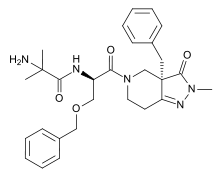Capromorelin
 | |
| Systematic (IUPAC) name | |
|---|---|
| N-[(2R)-1-[(3aR)-2-methyl-3-oxo-3a-(phenylmethyl)-6,7-dihydro-4H-pyrazolo[4,3-c]pyridin-5-yl]-1-oxo-3-(phenylmethoxy)propan-2-yl]-2-amino-2-methylpropanamide | |
| Clinical data | |
| Pharmacokinetic data | |
| Half-life | 2.4 hours[1] |
| Identifiers | |
|
193273-66-4 | |
| None | |
| PubChem | CID 216208 |
| ChemSpider |
187411 |
| UNII |
0MQ44VUN84 |
| ChEMBL |
CHEMBL113313 |
| Chemical data | |
| Formula | C28H35N5O4 |
| 505.609 g/mol | |
|
SMILES
| |
| |
| | |
Capromorelin (CP-424,391) is an investigational medication developed by the Pfizer drug company.[2] [3] It functions as a growth hormone secretagogue and ghrelin mimetic which causes the body to secrete human growth hormone in a way usually seen at puberty and in young adulthood. Initial studies have shown the drug to directly raise insulin growth factor 1 (IGF-1) and growth hormone levels.[4]
The drug is being considered for its therapeutic value in aging adults because elderly people have much lower levels of growth hormone and less lean muscle mass, which can result in weakness and frailty.[5]
In a one-year treatment trial (starting 1999) with 395 seniors between 65 and 84 years old, patients who received the drug gained an average of 3 lb (1.4 kg) in lean body mass in the first six months and also were better able to walk in a straight line in a test of balance, strength and coordination. After 12 months, patients receiving capromorelin also had an improved ability to climb stairs, however the results were not good enough to continue the trial for the 2nd planned year.[6]
Capromorelin, however, has not been approved by major regulatory bodies such as the World Health Organization, the European Medicines Agency or the United States FDA. In the U.S. at least, approval is not expected to be forthcoming any time soon, because the FDA does not consider aging a disease, and so requires extraordinary evidence of benefit and non-toxicity to approve a drug for use as an anti-aging agent.[7]
See also
- MK-677
- SM-130,686
- Tabimorelin
References
- ↑ Khojasteh-Bakht SC, O'donnell JP, Fouda HG, Potchoiba MJ. Metabolism, pharmacokinetics, tissue distribution, and excretion of [14C]CP-424391 in rats. Drug Metabolism and Disposition. 2005 Jan;33(1):190-9. PMID 15486077
- ↑ Carpino PA, Lefker BA, Toler SM, Pan LC, Hadcock JR, Murray MC, Cook ER, DiBrino JN, DeNinno SL, Chidsey-Frink KL, Hada WA, Inthavongsay J, Lewis SK, Mangano FM, Mullins MA, Nickerson DF, Ng O, Pirie CM, Ragan JA, Rose CR, Tess DA, Wright AS, Yu L, Zawistoski MP, Pettersen JC, DaSilva-Jardine PA, Wilson TC, Thompson DD. Discovery and biological characterization of capromorelin analogues with extended half-lives. Bioorganic and Medicinal Chemistry Letters. 2002 Nov 18;12(22):3279-82. PMID 12392732
- ↑ Carpino PA, Lefker BA, Toler SM, Pan LC, Hadcock JR, Cook ER, DiBrino JN, Campeta AM, DeNinno SL, Chidsey-Frink KL, Hada WA, Inthavongsay J, Mangano FM, Mullins MA, Nickerson DF, Ng O, Pirie CM, Ragan JA, Rose CR, Tess DA, Wright AS, Yu L, Zawistoski MP, DaSilva-Jardine PA, Wilson TC, Thompson DD. Pyrazolinone-piperidine dipeptide growth hormone secretagogues (GHSs). Discovery of capromorelin. Bioorganic and Medicinal Chemistry. 2003 Feb 20;11(4):581-90. PMID 12538023
- ↑ Pan LC, Carpino PA, Lefker BA, Ragan JA, Toler SM, Pettersen JC, Nettleton DO, Ng O, Pirie CM, Chidsey-Frink K, Lu B, Nickerson DF, Tess DA, Mullins MA, MacLean DB, DaSilva-Jardine PA, Thompson DD. Preclinical pharmacology of CP-424,391, an orally active pyrazolinone-piperidine growth hormone secretagogue. Endocrine. 2001 Feb;14(1):121-32. PMID 11322494
- ↑ Thompson DD. Aging and sarcopenia. Journal of Musculoskeletal and Neuronal Interactions. 2007 Oct-Dec;7(4):344-5. PMID 18094505
- ↑ Heidi K. White, Charles D. Petrie, William Landschulz, David MacLean, Ann Taylor, Kenneth Lyles, Jeanne Y. Wei, Andrew R. Hoffman, Roberto Salvatori, Mark P. Ettinger, Miriam C. Morey, Marc R. Blackman, George R. Merriam for the Capromorelin Study Group. Effects of an Oral Growth Hormone Secretagogue in Older Adults. Journal of Clinical Endocrinology & Metabolism. April 2009, Vol. 94, No. 4 1198-1206. doi:10.1210/jc.2008-0632. PMID 19174493
- ↑ Hersch EC, Merriam GR. Growth hormone (GH)-releasing hormone and GH secretagogues in normal aging: Fountain of Youth or Pool of Tantalus? Clinical Interventions in Aging. 2008;3(1):121-9. PMID 18488883
Researchers
- Pfizer
- Merck
- University of Washington/VA Puget Sound Health Care System: Dr. George Merriam
- University of Poland: Dr. Agnieszka Baranowska-Bik
External links
| ||||||||||||||||||||||||||||||||||||||||||||||||||||||||||||||||||||||||||||||||||||||||||||||||||||||||||||||||||||||||||||||||||||||||||||||||||||||||||||||